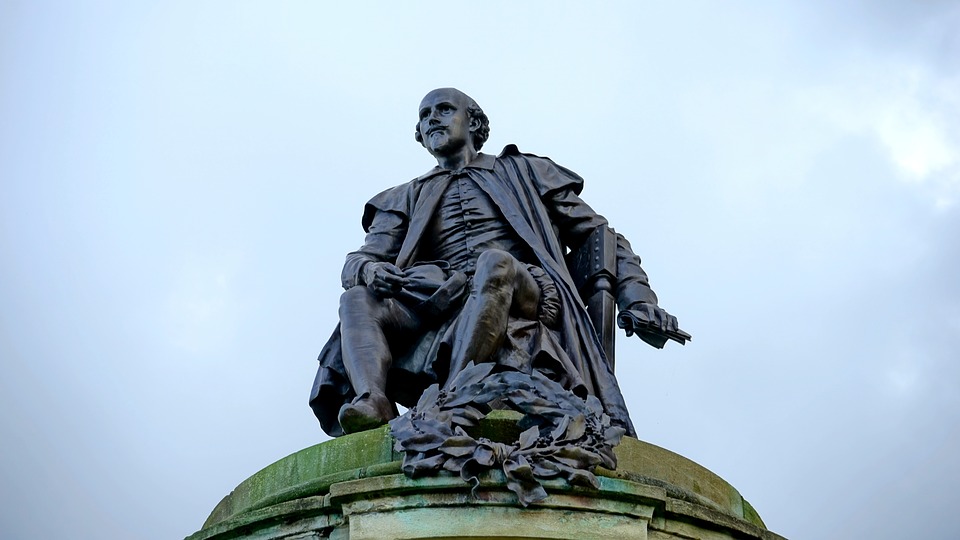Translating deep thinking into common sense
O, Tempora!

By Roger Donway
December 12, 2020
SUBSCRIBE TO SAVVY STREET (It's Free)
Book Review: All the Sonnets of Shakespeare, edited by Paul Edmondson and Stanley Wells (Cambridge: Cambridge University Press, 2020).
I recently pulled my life’s poetic works into a book. So, the question arose: How should the book be organized? “Theme” seemed the obvious answer. I have written a lot about unrequited love and a lot about elves. Surely, I thought, a reader would like to immerse himself in Languedoc for a while, and then move over to Elfland. But that structure, I finally decided, was not the most satisfying. The poems needed to be grouped by when they were written. The elves of my 20s, I saw, had more in common with the ladies of my 20s than they had in common with the elves of my 60s.
What if one tested that insight about organizing poems against Shakespeare’s sonnets?
The 154. It can refer either to the baseball season of the 1927 New York Yankees or to the sonnets of Shakespeare published as a book in 1609: SHAKE-SPEARES SONNETS. Never before imprinted (London: G. Eld for T.T.). The arguments about those poems and particularly their arrangement have been endless. This year, two eminent scholars of Shakespeare, Paul Edmondson and Stanley Wells, brought out a new arrangement, All the Sonnets of Shakespeare. Their central principle: Employ scholars’ growing ability to use computer analyses of an author’s linguistic development in order to arrange the sonnets by date of composition. Their secondary idea: Interlace, also by date, sonnets and sonnet-like passages from Shakespeare’s plays. What are the results?
In My End Is My Beginning: 1582-1593
The last sonnet (154) was actually Shakespeare’s first.
The first fruits of the Edmondson-Wells approach is the conclusion that the last sonnet (154) was actually Shakespeare’s first. And, in fact, it is not properly speaking a Shakespearean sonnet at all. It is a schoolboy translation exercise, attempting to render a six-line epigram from the 400s or 500s a.d. Byzantine poet Marianus Scholasticus. Sonnet 153 is simply an improved attempt at the same translation. Those of us who have labored over scholarly arguments as to why these two obviously out of place poems logically had to be the conclusion of the 1609 collection of sonnets—and had to serve as its transition to A Lover’s Complaint (also in the 1609 book)—will rejoice in knowing that we can now relax.
The first genuine love sonnet in the collection is No. 145, dated to 1582, the year of teenage Will Shakespeare’s marriage to Anne (Agnes) Hathaway. (He was 18; she 26, and a child was born six months after the marriage). Shakespeare’s use of the phrase “hate away” in this poem is presumed to be a pun on Anne’s last name. Oddly, the sonnet is truncated, being written in iambic tetrameter rather than iambic pentameter.
The illumination provided by Edmondson-Wells’s use of sonnets from the plays is initially shown by a passage from Two Gentleman of Verona, Shakespeare’s first (and perhaps weakest) romantic comedy. Published seven to nine years after the Hathaway poem, this quasi-sonnet is also truncated, though not metrically: it is fully iambic pentameter, but consists of only two quatrains and a couplet, not three quatrains. The idea is banal enough: I send my thoughts to Sylvia, and therefore those thoughts (who are my servants) have the good fortune to be where I (their master) would like to be.
Incidentally, I feel certain that that is what the poem says, because there is yet one more redundant reason for adding Edmonson-Wells to your library: Pages 233 to 290 give literal prose paraphrases of every sonnet and semi-sonnet included in the main text.
The Overall Structure
 For centuries, the alleged meaning of Shakespeare’s sonnets struck most ordinary readers as simply odd. These, we were told, were the verses of the greatest sonnet collection in human history, yet the poet spent the first 126 of his 154 sonnets addressing a young male friend. And the opening seventeen poems of the collection, presumably its most important part, were devoted to urging this vain young man to marry and procreate in order to perpetuate himself and his virtues. It seemed weird.
For centuries, the alleged meaning of Shakespeare’s sonnets struck most ordinary readers as simply odd. These, we were told, were the verses of the greatest sonnet collection in human history, yet the poet spent the first 126 of his 154 sonnets addressing a young male friend. And the opening seventeen poems of the collection, presumably its most important part, were devoted to urging this vain young man to marry and procreate in order to perpetuate himself and his virtues. It seemed weird.
Edmonson and Wells show us an altogether different picture. Yes, the first 17 sonnets in the collection are addressed to a young man, urging him to marry. But these are not “the opening” of Shakespeare’s sonnets. They date from 1595 to 1597, the climax of the sonnet-sequence rage. They are written after such immortal works as No. 73. “That time of year thou mayest in me behold.” And there is no reason to think that they are all addressed to the same young man. A sonneteer urging a young man to marry and reproduce was every bit as much of a cultural trope as a troubadour writing a ballad urging a married woman to surrender her chastity. Writing a bunch of poems on that topic, therefore, was no odder than writing a bunch of seductive songs. The theoretical foundation was Desiderius Erasmus’s essay “Epistle to Persuade a Young Man to Marriage.”
More important still, the idea that the next 109 sonnets are also addressed to the young man is simply nonsense. Edmondson and Wells go through those poems one by one and find that in 90 of the 109 sonnets, the sex of the addressee and the speaker cannot be determined. In several other cases, the poem is a meditation addressed to no one. In several more cases, the addressee is a male rival. In a few cases—Nos. 63, 67, and 68—the addressee is clearly a male, but then the speaker may be a woman. The editors’ inclusion of sonnets from the plays makes clear about the familiar sonnets what we should always have known: Shakespeare was a playwright who imagined speakers and listeners into their situations. If he had simply written about Shakespeare, he would not be Shakespeare.
The Dark Lady: 1590–1595
Sonnets 127 through 152, the Dark Lady sonnets, which we have always been taught constitute the final section, are actually the chronologically first section of the famous collection, dating from between 1590 and 1595, the very height of the sonnet-sequence craze in Elizabethan England. Did Shakespeare intend these poems to a Dark Lady to be a sonnet sequence, only to see the craze for sequences die out? Who knows? The only plays from this period familiar to most readers, I suppose, are The Taming of the Shrew and Richard III, maybe Richard II; none of them employ sonnets or quasi-sonnets. But as in those plays, so even in these early sonnets, Shakespeare was achieving greatness. The opening line of No. 130 is known to all who know the sonnets even slightly. “My mistress’ eyes are nothing like the sun.” One of the firmest conventions of sonnet writing was to write that one was violating the conventions of sonnet writing. But No. 130 does it better than most. “And yet, by heaven, I think my love as rare / As any she belied by false compare.”
Still, I must say a word for No. 129, that poem’s numerical and chronological predecessor. Edmondson and Wells call it: “An almost breathless meditation on the feelings and consequences of lust.” And so it is. The dense language of No. 129 reminds me of Dylan Thomas. Shakespeare writes: “Perjured, murd’rous, bloody, full of blame, / Savage, extreme, rude, cruel, not to trust.” Other greats this early on? No. 137: “Thou blind fool, Love, what dost thou to mine eyes / That they behold and see not what they see?”
Lastly, I must say a word for two more poems of this era. No. 148. “O me, what eyes hath love put in my head, / Which have no correspondence with true sight!” And No. 150, which always reminds me of C. S. Lewis and his love for the loudmouthed American Joy Davidman, whom his British intellectual friends could not stand. “O, though I love what others do abhor.” Been there.
The Core Sonnets: 1594–1595
Shakespeare was like Beethoven, not Mozart. Both had a capacity for being powerfully lousy, which Mozart simply could not be. But when at their greatest, Shakespeare and Beethoven, there was no one greater.
Shakespeare was like Beethoven, not Mozart. Both had a capacity for being powerfully lousy, which Mozart simply could not be. But when at their greatest, Shakespeare and Beethoven, there was no one greater. The Sonnets from No. 61 to No. 103, written during 1594 and 1595, demonstrate that in Shakespeare’s case. So, too, does the immortal conversation sonnet between Romeo and Juliet, which also dates from these years: “If I profane with my unworthiest hand.”
No. 62. “’Tis thee, my self, that for myself I praise.” I love myself because you love me. A twist on Ayn Rand’s assertion: “To say ‘I love you,’ one must first say ‘I.’” “To say I am lovable, I must first say ‘I am loved.’” But by one who is my very self. No. 64. I will lose you: “That time will come and take my love away.” No. 65. My poetry will preserve my love: “In black ink my love may still have might.” No. 66. I seek death but would not leave you: “Save that to die I leave my love alone.” And on and on and on. No. 73. “That time of year thou mayest in me behold.” No. 75. “So are you to my thoughts as food to life.” No. 76. “O know, sweet love, I always write of you.” And, painfully, No. 87. “Farewell—thou art too dear for my possessing.” Been there, too.
Conclusion
We tend to think of sonnets as love sonnets, but in Shakespeare’s collection there are really only three love poems, although admittedly they are among the greatest: Nos. 18, 29, and 116. “Shall I compare thee to a summer’s day.” “When in disgrace with Fortune and men’s eyes.” and “Let me not to the marriage of true minds.” Shakespeare was a playwright. That is what we must always remember when reading his poetry. He was not a lyric poet. He was what History has termed him: The Bard. What he enjoyed was describing a person in a situation. It might be a situation he had experienced; it might not be. It might be a male’s perspective; it might be a female’s viewpoint. Didn’t matter. Attitude, relationships, juxtapositions. Behavior was the thing he found worth describing in his sonnets. O mores!









